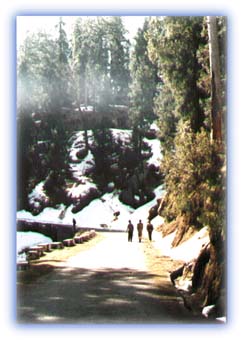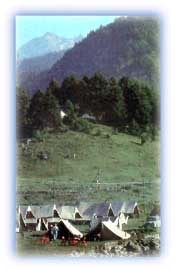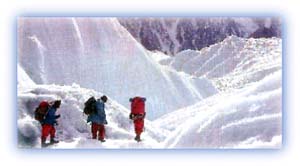Trekking
· Prerequisites
· The Terrain
· Trekking Methods
· Preparations
· Physical Conditioning
· Acclimatization
· High Altitude Sickness
· Food and Water
· Exchange of Currency
· Trekking Permits

![]()
| General Info The Himalayas, over the centuries, have attracted trekkers, mountaineers, pilgrims and ascetics. Since time immemorial its rugged heights crowned with snow and draped in vast glaciers has lured man to pit his courage and ingenuity against its dangerous challenge. |
 |
| Walking and enjoying the sunshine, snow and greenery. Credit: Debangsu Sengupta |
Below the snowline at 18,000 feet, nature appears to relent and from the austere magnificence of the heights brings down to a different world of cascading water falls, lush green forests, flower-bedecked meadows and a variety of flora and and fauna. Here the rivers flow clear blue and icy.
Here nestle small villages and hamlets with their diverse local customs, dances, folklore and architecture. The people are as vibrant as their surroundings and in many cases innocent of the sometimes dubious benefits of modern civilization.
Since ancient times, ascetics have climbed into these inhospitable heights in search of peace. In doing so, they have established places of pilgrimage that have become more than household names since their fame has spread to all parts of the world. Names like Kailash Mansarovar, in Tibet, Thyang Boche in Nepal, and of course Badrinath, Kedarnath, Yamunotri, Gangotri of Uttarakhand. Then there is Amarnath in Kashmir and Hemis in Ladakh.
 |
| Tented accomodation at Pahalgam Credit: KOA |
Those first mountaineers - whether ascetics, pilgrims, traders, hunters or shepherds - had no special training or climbing techniques, but acquired a high degree of skill from necessity and constant practice. Having to cross the mountain passes at heights ranging from 1500 m to 5,800 m, they designed ingenious equipment, food and clothing from indigenous material to help them combat the intense cold and negotiate the treacherous snow and ice.
For a vast number of people, the Himalayas appear to be the Shangri-la, to others, the abode of God.
Trekking in the Himalayas is now quite enjoyable and has become comparatively easy with the development of lightweight equipment and clothing with booming tourist infrastructure. There are difficult treks as well as easy treks, long and short treks. Vehicles, helicopters and aircrafts are also available to explore the Himalayas according to one's resources, taste and leisure time. But you still find people in remote mountain villages who maintain the age old traditions and have not changed for generations. There is much that is new and interesting in the Himalayan villages.
 |
| In the high snows... mountaineering opportunities in the Himalayas excite even professionals. Credit: KOA |
Stan Armington has rightly said that "Trekking is neither a wilderness experience nor is it a climbing trip". Even at a height of 12,000 to 14,000 feet in secluded valleys, there are small village settlements tending their flocks of sheep and goats or herds of Yaks of nomadic shepherds and Gujjars. As a result, there are people on the trail to guide and help you - the trekkers. Articles of daily necessity are also available in these small hamlets. Even in the remote areas one can easily mix with the people and 'live off the land". Most westerners find it difficult to comprehend this aspect and visualize their trekking trips to be the same as those organized in their national parks or in wilderness area of their respective countries.
Almost all the Himalayan valleys are full of rural settlements and the population gradually thins out with the rise in altitude. One always finds people on the trekking trails and there is no dearth of information as to trekking routes and directions. Hill people are traditionally very hospitable and this adds pleasure to trekking in the Himalayas more than anywhere else. Some people believe that trekking in the Himalayas is a climbing trip where they have to negotiate rocky cliffs, thick jungles and uncharted routes. But this is not so. In almost all Himalayan regions, the local people have well developed trails. There are routes from one village to the other, between adjoining mountain pastures and across well defined high altitude passes, where people travel from one valley to other for trade, cultural exchanges, religious activities and inter - marriages.
 |
| Morning sunshine on the mountain slopes Credit: Karamjeet Singh |
These mountain trails and high passes normally do not require any mountaineering skills or artificial climbing aids. Of course, at places, they are covered with snow and may have crevasses. However, these obstacles can usually be crossed without the aid of mountaineering equipment like ropes and pitons. There are only a few difficult treks which need mountaineering techniques or equipment. An example is the trek to the Nanda Devi Sanctuary in India or a trek across several high passes which require special equipment to negotiate the glaciers.
Trekking is more enjoyable than climbing the peaks and offers spectacular scenic beauty. The Himalayan region, till now, has been comparatively less affected by the modern urban civilization with its industrial pollution. It provides an opportunity to be in natural surroundings and to get away from the milling crowds of the cities. The trekker usually returns home rejuvenated, and with new enthusiasm to take up the challenges of city life.
All rights reserved